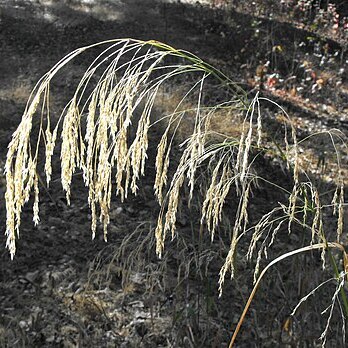Loosely tufted, erect, perennial, branching at nodes, from short creeping rhizomes; branching extravaginal; cataphylls densely hairy. Leaf-sheath firmly membranous, smooth, sometimes terminating in a tuft of minute hairs. Ligule to 1.5 mm, truncate, entire. Leaf-blade to 40 cm × 5.5 mm, flat or involute, abaxially smooth, but scaberulous towards filiform tip and on margins, adaxially finely scabrid and with scattered soft hairs. Culm to 130 cm, wiry, glabrous. Panicle to 60 cm, lax; branches capillary, ascending to spreading, in dense distant whorls, rachis smooth, branches and pedicels scaberulous. Glumes subequal, 3-4 mm, 3-nerved, acute, often purple; lower slightly keeled and scabrid near tip. Lemma to 2.5 mm, 3-nerved, firmly membranous, smooth, shallowly lobed at apex; awn to 4.5 mm, straight, caducous. Palea ≈ lemma, 2-nerved, glabrous. Callus minute, blunt, glabrous. Lodicules 3. Anthers to 1.7 mm, penicillate.
More
Plants to 1.5 m tall, with a contracted rhizome with extravaginal innovations. Leaves: ligule 2–3 mm long, obtuse or truncate; blade flat or rarely loosely rolled, 8–10 mm wide, slightly scabrous. Inflorescence 15–40 cm long, open, sparse. Glumes slightly unequal, 3–3.5 mm long, long-acuminate, membranous to hyaline. Lemma ovoid, 1.8–2 mm long, hardened and shining at maturity, smooth, glabrous; awn straight, capillary, 2–4 mm long. Palea as long as lemma, 2-nerved. Anthers c. 1 mm long.
A herb. It is an erect grass that keeps growing from year to year. It has underground stems or rhizomes. It grows 60-100 cm tall. The stalks are 2 mm across. The leaves are narrow and 20-25 cm long by 5 mm wide.

